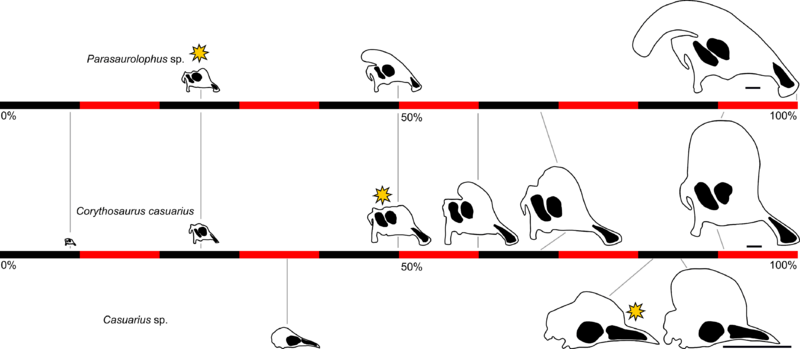Image: Parasaurolophus-Corythosaurus-Casuarius growth

Description: Cranial growth series for Parasaurolophus sp., Corythosaurus casuarius, and Casuarius sp., showing changes in bony ornamentation relative to maximum reported skull length for each taxon. The black and red scale indicates percentage of maximum reported skull length in increments of 10 percent. The yellow sunburst indicates the approximate skull size at which ornamentation initially appears. Note that Parasaurolophus develops its crest at a very small skull size relative to Corythosaurus, and both hadrosaurids initiate the development of cranial ornamentation at a smaller relative skull size than in Casuarius. Skulls for Parasaurolophus sp. are based on RAM 14000, a hypothetical subadult (Fig. 11B), and the holotype for Parasaurolophus cyrtocristatus (FMNH P 27393, with missing elements patterned after ROM 768). The growth series for Corythosaurus is a composite, with the two smallest skulls (at left) patterned after Hypacrosaurus stebingeri. Because the two taxa are so closely related, and because they show broadly similar patterns of cranial growth where individuals of overlapping size are known (Evans, 2010; Brink et al., 2011), we consider this a reasonable assumption. The smallest skull (at left) is based on RTMP 89.79.52, 87.79.206, 87.79.241, 87.77.92, and 87.79.333, and represents an embryonic individual (redrawn from Horner & Currie, 1994). The next smallest skull is patterned after MOR 548 (also redrawn from Horner & Currie, 1994). The remaining skulls, from left, are patterned after ROM 759, CMN 34825, ROM 5856, and ROM 871, redrawn from Evans (2010). Skulls of Casuarius are redrawn from Dodson (1975) and based on (from left) YPM 6208, YPM 1736 (snout region reconstructed), and AMNH 3870. Maximum skull lengths for Parasaurolophus, Corythosaurus, and Casuarius are 745 mm (ROM 768), 750 mm (ROM 792) and 200 mm, respectively (Dodson, 1975; Evans, 2010). Scale bars equal 10 cm.
Title: Parasaurolophus-Corythosaurus-Casuarius growth
Credit: http://peerj.com/articles/182
Author: Andrew A. Farke, Derek J. Chok, Annisa Herrero, Brandon Scolieri, Sarah Werning
Permission: http://peerj.com/
Usage Terms: Creative Commons Attribution 4.0
License: CC BY 4.0
License Link: http://creativecommons.org/licenses/by/4.0
Attribution Required?: Yes
Image usage
The following page links to this image:

